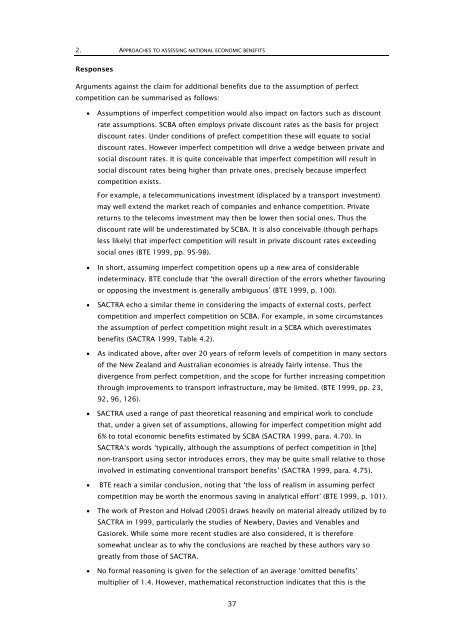Research 350 - NZ Transport Agency
Research 350 - NZ Transport Agency
Research 350 - NZ Transport Agency
Create successful ePaper yourself
Turn your PDF publications into a flip-book with our unique Google optimized e-Paper software.
2. APPROACHES TO ASSESSING NATIONAL ECONOMIC BENEFITS<br />
Responses<br />
Arguments against the claim for additional benefits due to the assumption of perfect<br />
competition can be summarised as follows:<br />
• Assumptions of imperfect competition would also impact on factors such as discount<br />
rate assumptions. SCBA often employs private discount rates as the basis for project<br />
discount rates. Under conditions of prefect competition these will equate to social<br />
discount rates. However imperfect competition will drive a wedge between private and<br />
social discount rates. It is quite conceivable that imperfect competition will result in<br />
social discount rates being higher than private ones, precisely because imperfect<br />
competition exists.<br />
For example, a telecommunications investment (displaced by a transport investment)<br />
may well extend the market reach of companies and enhance competition. Private<br />
returns to the telecoms investment may then be lower then social ones. Thus the<br />
discount rate will be underestimated by SCBA. It is also conceivable (though perhaps<br />
less likely) that imperfect competition will result in private discount rates exceeding<br />
social ones (BTE 1999, pp. 95-98).<br />
• In short, assuming imperfect competition opens up a new area of considerable<br />
indeterminacy. BTE conclude that ‘the overall direction of the errors whether favouring<br />
or opposing the investment is generally ambiguous’ (BTE 1999, p. 100).<br />
• SACTRA echo a similar theme in considering the impacts of external costs, perfect<br />
competition and imperfect competition on SCBA. For example, in some circumstances<br />
the assumption of perfect competition might result in a SCBA which overestimates<br />
benefits (SACTRA 1999, Table 4.2).<br />
• As indicated above, after over 20 years of reform levels of competition in many sectors<br />
of the New Zealand and Australian economies is already fairly intense. Thus the<br />
divergence from perfect competition, and the scope for further increasing competition<br />
through improvements to transport infrastructure, may be limited. (BTE 1999, pp. 23,<br />
92, 96, 126).<br />
• SACTRA used a range of past theoretical reasoning and empirical work to conclude<br />
that, under a given set of assumptions, allowing for imperfect competition might add<br />
6% to total economic benefits estimated by SCBA (SACTRA 1999, para. 4.70). In<br />
SACTRA’s words ‘typically, although the assumptions of perfect competition in [the]<br />
non-transport using sector introduces errors, they may be quite small relative to those<br />
involved in estimating conventional transport benefits’ (SACTRA 1999, para. 4.75).<br />
• BTE reach a similar conclusion, noting that ‘the loss of realism in assuming perfect<br />
competition may be worth the enormous saving in analytical effort’ (BTE 1999, p. 101).<br />
• The work of Preston and Holvad (2005) draws heavily on material already utilized by to<br />
SACTRA in 1999, particularly the studies of Newbery, Davies and Venables and<br />
Gasiorek. While some more recent studies are also considered, it is therefore<br />
somewhat unclear as to why the conclusions are reached by these authors vary so<br />
greatly from those of SACTRA.<br />
• No formal reasoning is given for the selection of an average ‘omitted benefits’<br />
multiplier of 1.4. However, mathematical reconstruction indicates that this is the<br />
37
















